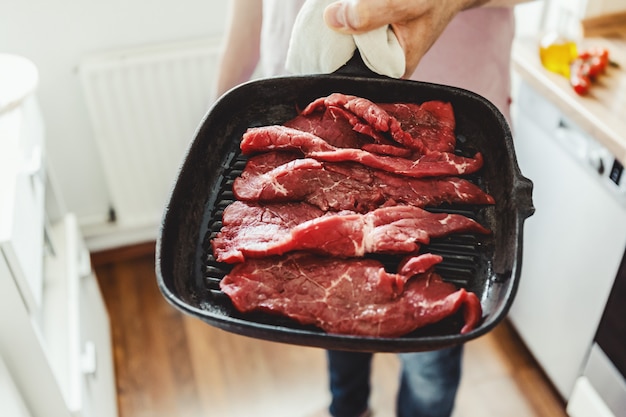There’s a certain magic in the sizzle of a perfectly seared steak, the aroma of sizzling fat, and the promise of juicy, flavorful bites. For me, that magic is amplified tenfold when it's cooked in a trusty cast iron skillet. There's just something about the way a cast iron pan holds heat and creates that irresistible crust that elevates the humble steak to new heights.
This guide isn't just about throwing a steak on a hot pan, it's about unlocking the secrets of achieving steak perfection. It's about transforming an ordinary piece of meat into a culinary masterpiece. It's a journey I've been on for years, learning and tweaking techniques, and discovering the little details that make all the difference.
Ready to join me? Let's dive in.
(Part 1) choosing the right cut: The Foundation of Flavor

A Steak for Every Taste
Picking the right cut is the first step to a successful steak. It’s like choosing the right canvas for your masterpiece. Do you crave a tender, buttery texture? Or are you after something leaner, with a more pronounced beefy flavor?
- Ribeye and new york strip: If you're after that classic, melt-in-your-mouth experience, look no further. These cuts are generously marbled, meaning they have tiny threads of fat running through the meat. This fat renders during cooking, adding rich, buttery flavor and keeping the steak incredibly juicy.
- Sirloin and Tenderloin: These cuts are known for their leanness and tender texture. They're a fantastic choice if you're looking for a lighter, more savory steak. While they might not have the same buttery richness as the ribeye, they boast a clean, pronounced beef flavor.
- chuck roast and flank steak: These cuts are tougher than the others, but with the right techniques, they can be transformed into tender, flavorful meals. Think slow cooking, braising, or grilling over low heat. The longer cooking times break down the tough connective tissue, resulting in a juicy and satisfying steak.
Thickness Matters: The Key to Even Cooking
Don’t get caught up in thin steaks. Aim for a cut that's at least 1 inch thick. Why? Think about heat penetration. Thicker steaks provide a barrier, preventing the inside from becoming cold while the outside overcooks. This allows for even cooking and a beautifully pink interior. Plus, a thicker steak can handle a higher sear temperature, leading to that coveted crispy crust.
Marbling: The Secret Ingredient
I can’t overstate the importance of marbling. It's not just about aesthetics. Those little streaks of fat are like tiny flavor bombs, releasing their deliciousness as they melt during cooking. It's the marbling that adds richness, juiciness, and that unforgettable buttery quality. So, don't shy away from a well-marbled steak; it’s a sign of a truly delicious experience to come.
(Part 2) Prepping for Success: Setting the Stage for Steak Perfection

Room Temperature: The Key to Even Cooking
Imagine a cold steak hitting a blazing hot skillet. The outside sears immediately, while the inside remains cold, leading to uneven cooking. That’s why bringing your steak to room temperature is crucial. It's like letting the steak gently acclimate to the heat before it takes center stage on the pan. Take your steak out of the fridge about 30-45 minutes before you start cooking. This ensures a more even cooking process, resulting in a juicier, more flavorful steak.
Salt: The Flavor Amplifier
Salt isn't just a seasoning; it's a flavor enhancer. It works its magic by drawing moisture out of the steak, which then redistributes, creating a more tender and flavorful result. It also helps build a crispy, delicious crust on the surface. The earlier you salt, the better. Season your steak generously with kosher salt at least 30 minutes before cooking. Give the salt time to work its magic and penetrate the meat for maximum flavor.
Pepper: A Touch of Spice
Freshly ground black pepper adds another layer of flavor to your steak. Use a generous amount, but remember that a little goes a long way. Resist the urge to add other spices at this stage. Keep it simple for the best flavor. I like to grind fresh pepper just before cooking, allowing the aroma to fill the kitchen.
(Part 3) The Cast Iron Chronicles: Your Steak’s Faithful Companion

Choosing Your Cast Iron Skillet: Finding Your Perfect Partner
A good cast iron skillet is an investment worth making. It's not just a tool; it's a culinary companion that will last a lifetime. I recommend a 10-12 inch skillet for a steak that's at least 1 inch thick. It provides ample space for a beautiful sear without crowding the pan, allowing the steak to cook evenly.
Seasoning Your Cast Iron: The Art of Preservation
Imagine your cast iron skillet as a canvas, and the seasoning as a protective layer, preventing rust and promoting a non-stick surface. Seasoning your cast iron is a ritual that creates a smooth, dark surface that makes cooking a joy. It's a process that transforms the raw metal into a reliable cooking surface that can withstand years of use.
Preheating is King: Creating the Right Environment
A hot pan is the key to a perfect sear. Think of it as creating a blazing inferno for your steak to bathe in. Preheat your cast iron skillet over medium-high heat for 5-10 minutes. The pan should be hot enough that a drop of water sizzles and evaporates instantly. This scorching heat ensures that the steak sears quickly, creating a flavorful crust while keeping the inside juicy and tender.
(Part 4) The Art of Searing: Transforming Steak into a Culinary Masterpiece
Don’t Crowd the Pan: Giving Each Steak Its Own Space
Remember those tiny little flavor bombs we talked about? The marbling? They need to breathe! Don't overcrowd the pan. Give each steak its own space to sear properly. If you're cooking more than one steak, work in batches, ensuring that each piece has direct contact with the hot pan for a delicious, even crust.
Let It Sizzle: Resisting the Urge to Peek
Patience is a virtue, especially when it comes to searing a steak. Resist the urge to peek or move the steak too soon. Let it cook undisturbed for 2-3 minutes per side before flipping. This allows for a beautiful, crispy crust to develop, trapping in the juices and creating that incredible flavor. The sizzle you hear is the sound of deliciousness happening.
Mastering Doneness: The meat thermometer’s Role
There's a fine line between a perfectly cooked steak and one that's overdone. That’s where a meat thermometer comes in. It’s your trusty guide to achieving the perfect level of doneness. Use it to ensure the steak reaches your desired internal temperature:
| Doneness | Internal Temperature (°F) | Internal Temperature (°C) |
|---|---|---|
| Rare | 125-130 | 52-54 |
| Medium-Rare | 130-135 | 54-57 |
| Medium | 140-145 | 60-63 |
| Medium-Well | 150-155 | 65-68 |
| Well-Done | 160 | 71 |
Resting: Unlocking the Full Potential of Flavor
After all that searing, resist the urge to dig in right away. Give your steak a well-deserved rest for 5-10 minutes before slicing. It's like letting the steak catch its breath and redistribute those delicious juices throughout the meat. This resting period ensures a more tender, flavorful, and evenly cooked steak. Cover the steak loosely with foil to keep it warm while it rests.
(Part 5) Taking It to the Next Level: Elevate Your Steak Experience
Adding a Touch of Butter: The Ultimate Indulgence
After you remove the steak from the pan, add a knob of butter. As the butter melts and sizzles, it infuses the pan with an incredible flavor that you can use to baste the steak. This creates a beautiful, shiny surface and adds an extra layer of richness. I like to add a sprig of rosemary or a few cloves of garlic to the butter for an added depth of flavor.
Finishing with Herbs: A Touch of Freshness
A sprinkle of fresh herbs like parsley, thyme, or chives adds a final touch of brightness and freshness to the steak. It balances out the rich flavors of the meat and creates a more complex and satisfying taste. Think of it as a finishing touch, like adding a splash of color to a painting.
(Part 6) Sides for Steak Night: Completing the Feast
Steak deserves the perfect sidekicks. Here are some of my favorites that enhance the flavor and texture of the main event:
- Roasted Vegetables: Brussels sprouts, asparagus, and carrots are classics for a reason. Roasting brings out their natural sweetness and creates a beautiful caramelization. The contrasting textures and flavors play perfectly with the steak.
- Creamy mashed potatoes: A comforting and classic side that complements the richness of the steak. The creamy texture provides a delightful contrast to the crispy crust of the steak.
- grilled corn on the Cob: A touch of sweetness and smoky flavor adds another dimension to your meal. The char from grilling adds a nice textural contrast to the steak.
- Garlic Bread: Simple and satisfying, garlic bread is a crowd-pleasing side that complements the rich flavors of the steak. The buttery garlic flavor is a perfect pairing.
(Part 7) Steak Night at Home: Creating a Special Occasion
There's something special about cooking a steak at home. It's a chance to create a relaxing atmosphere, enjoy good company, and indulge in a delicious meal. I love setting the table with a nice tablecloth, napkins, and my favorite dinnerware. Dimming the lights and putting on some relaxing music adds to the ambiance. It's all about creating a special experience, a moment to savor the fruits of your labor.
After the steak has rested, I arrange the sides beautifully on a platter and pour a glass of red wine. As I take the first bite, I'm reminded of the joy of cooking and sharing a meal with loved ones. There's a sense of accomplishment, a feeling of satisfaction that comes from creating something delicious with your own hands. It's more than just a meal; it's a celebration of good food and good company.
(Part 8) FAQs: Addressing the Common Questions
1. What if my steak sticks to the pan?
Don't panic! It happens to the best of us. A properly seasoned cast iron skillet should prevent sticking, but sometimes, a stubborn steak just needs a little extra coaxing. Gently loosen the steak with a spatula and let it cook for a bit longer. The crust should eventually release. If it's still stuck, use a wooden spoon to pry it loose, but be careful not to tear the steak. It's okay to use a little force, but try to be gentle.
2. How do I know when the steak is cooked to my liking?
A meat thermometer is the most reliable way to achieve your desired doneness. But if you don't have one, you can use the "touch" method. Press the centre of the steak with your finger:
- Rare: The steak will feel soft and mushy.
- Medium-Rare: The steak will feel springy and slightly firm.
- Medium: The steak will feel firm and springy.
- Medium-Well: The steak will feel very firm and springy.
- Well-Done: The steak will feel rock hard.
Remember, this is just a guide, and everyone's touch is different. The best way to learn is to practice and experiment. You'll soon develop a feel for how a steak cooks and what it feels like when it reaches your desired doneness.
3. Can I cook a steak in a regular pan?
Yes, you can cook a steak in a regular pan, but a cast iron skillet is ideal for achieving a perfect sear. If you're using a regular pan, ensure it's preheated thoroughly and use high heat. Add a tablespoon of oil to the pan to prevent sticking. It may not be as effective at creating that beautiful, crispy crust as a cast iron skillet, but it can still produce a delicious steak.
4. What if I don’t have fresh herbs?
Don’t let the lack of fresh herbs deter you! Dried herbs are a great alternative. Just use a smaller amount than you would for fresh herbs because dried herbs are more concentrated. They’ll still add a delightful touch of flavor to your steak.
5. Can I cook a steak in the oven?
Yes, you can cook a steak in the oven. It's a great option for larger steaks or if you're cooking several steaks at once. Preheat the oven to 400°F (200°C). Season the steak and place it on a baking sheet. Cook for 10-12 minutes for medium-rare. Use a meat thermometer to ensure the steak reaches your desired doneness. While you won’t get the same crispy crust as with a cast iron pan, the oven method can still produce a juicy and delicious steak.
Remember, mastering the art of cooking a perfect steak takes time and practice. Don't be afraid to experiment, try new techniques, and adjust your approach based on your preferences. The journey to steak perfection is as rewarding as the final result. So go forth, embrace the sizzle, and enjoy the delicious fruits of your culinary adventures.
Everyone is watching

Prime Rib Roast Cooking Time Chart: Per Pound Guide
Cooking TipsPrime rib roast. Just the name conjures images of lavish dinners, crackling fires, and hearty laughter. It’s ...

How Long to Bake Potatoes in the Oven (Perfect Every Time)
Cooking TipsBaked potatoes are a staple in my kitchen. They're incredibly versatile, delicious, and surprisingly easy to m...

Perfect Rice Every Time: The Ultimate Guide to Cooking Rice
Cooking TipsAs a self-proclaimed foodie, I've always been a bit obsessed with rice. It's the foundation of countless cuisi...

The Ultimate Guide to Cooking Asparagus: Tips, Techniques, and Recipes
Cooking TipsAsparagus. The mere mention of this spring delicacy conjures up images of vibrant green spears, crisp and burs...

Ultimate Guide to Cooking the Perfect Thanksgiving Turkey
Cooking TipsThanksgiving. Just the word conjures up images of overflowing tables laden with delicious food, the scent of r...
